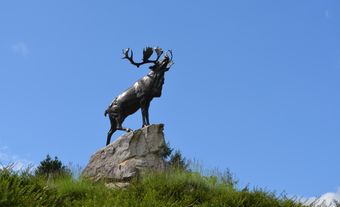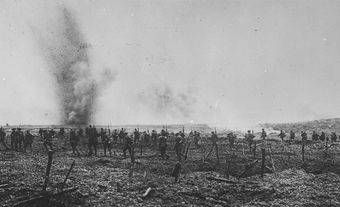The Newfoundland Regiment was established in September 1914 and served overseas during the First World War. It was redesignated the Royal Newfoundland Regiment in 1918. The regiment served in the Gallipoli (or Dardanelles) campaign, and in France and Belgium. It suffered heavy casualties during the Battle of Beaumont-Hamel on 1 July 1916; more than 80 per cent of the regiment was either killed or wounded. The regiment was disbanded in 1919. In 1949, after Newfoundland entered into confederation with Canada, the Newfoundland Regiment was re-established as a Royal Canadian Infantry Corps reserve regiment.

Early Newfoundland Regiments
There is a long history of military service in Newfoundland and Labrador, dating from at least the 18th century. His Majesty's Newfoundland Regiment of Foot (1780–83), for example, was raised during the American Revolutionary War to protect the colony against attack. During the French Revolutionary Wars, the Royal Newfoundland Regiment of Foot (or Royal Newfoundland Regiment of Fencible Infantry) defended British interests from 1795 until 1802, when it was disbanded. Little more than a year later, British troops were recalled in order to defend against the threat of invasion from Napoleonic France (see Napoleonic Wars). To defend the colony, the Newfoundland Regiment of Fencible Infantry was formed in 1803. By 1806, it had become the Royal Newfoundland Regiment. The regiment spent a year garrisoned in Nova Scotia before it was sent to Quebec in 1807 to defend against the threat of American invasion. The Royal Newfoundland Regiment saw significant action during the War of 1812 and was disbanded in 1816.
Newfoundland and the First World War
On 4 August 1914, a telegram informed Governor Sir Walter Davidson that the British Empire was at war with Germany. (See First World War.) At the beginning of the war, Newfoundland had almost no military establishment. The only official military organization on the island was the Newfoundland Royal Naval Reserve that trained sailors for service in the Royal Navy. Despite the lack of military infrastructure, it quickly became apparent that many citizens wanted to raise a contingent of Newfoundland soldiers instead of encouraging men to serve in Canadian or British regiments. Forming a Newfoundland Regiment would be an uphill battle, as the closest thing the Dominion had to a militia was the Legion of Frontiersmen (an empire-wide civilian organization of marksman) and several denominational cadet corps.
Newfoundland Regiment: Formation and Recruiting
The first recruiting drive started on 21 August 1914 and was highly successful. By 11 September, 880 men had been enrolled and 520 were deemed fit for service. Over 80 per cent of these men were from St. John’s, and the majority were members of the various denominational cadet corps. The Newfoundland Patriotic Association was concerned about the lack of rural participation in the regiment, so it suspended recruitment in the city to allow time for rural volunteers to enlist.
By 28 September, 920 men had enlisted and 565 men were accepted; they began training at Pleasantville in St. John’s. Despite Governor Davidson’s intention to supply a contingent of 500 soldiers, the British government informed him that this was not enough for a battalion. If the Dominion wanted its soldiers to serve in a distinct Newfoundland Regiment, they would need to recruit at least 1,080 men with an additional 250 soldiers in reserve.
On 4 October, the SS Florizel set sail for the United Kingdom with the regiment’s first contingent. These 537 soldiers are known as the “First Five Hundred.” The rest of the men joined the unit in the UK.
The Newfoundland Regiment at Gallipoli
In August 1915, the regiment learned it would be sent to the Gallipoli Peninsula, where it would be attached to 88th Brigade, 29th Division. On 1 September, it arrived in Egypt, where the men spent two weeks adapting to the heat before setting sail again. On 20 September 1915, the regiment landed at Kangaroo Beach.
On the beaches of Gallipoli, the Regiment was constantly harassed by Turkish snipers and artillery and plagued by disease. Gasoline often polluted their limited drinking water, and flies infested their food. These contaminants spread disease and caused illness. Nearly every soldier suffered from dyspepsia or diarrhea, while jaundice and dysentery plagued the less fortunate. Despite these horrendous conditions, the regiment was able to carve out a small victory that came to be known as “Caribou Hill,” when a raiding party eliminated a sniper’s nest and captured a hill that eventually became part of the British front lines.
In November, the British War Committee ordered an evacuation of the Gallipoli Peninsula. From this point until December, 29th Division slowly and quietly withdrew to Egypt. A detachment of Newfoundlanders helped cover the evacuation of the last troops from the beaches. On 9 January, a group of men led by Lieutenant Owen William Steele were among the soldiers on the last barge to depart the peninsula. During its time in Gallipoli, the Newfoundland Regiment suffered 30 fatalities from action and another 10 from disease.

The Newfoundland Regiment at Beaumont-Hamel
In March 1916, the regiment was sent to France to take part in the initial phase of the Battle of the Somme. Twenty-Ninth Division’s objective was to capture a section of German trench known as Y Ravine approximately 550 m from the British frontline near the little village of Beaumont-Hamel. In the seven days preceding the attack, British artillery bombarded the German trenches to cut barbed wire and destroy German artillery and troop positions. Despite the division commander’s confidence, most of the deep German dugouts were untouched. At 7:20 a.m. on 1 July 1916, a mine was detonated at Hawthorne Ridge, a German strongpoint. But the German defenders were prepared. The preceding artillery barrage warned them that an attack was coming, and the Hawthorne mine told them it would come soon. Shortly after the mine detonated, the Germans were in a strong defensive position. The initial British troops faced heavy machine-gun and rifle fire as they advanced from their trenches at 7:30 a.m.

The Newfoundland Regiment was part of the attack’s second wave. Initially, it was supposed to advance alongside the 1st Essex. However, the Commanding Officer of the 1st Essex requested a delay to clear their communication trench. The request was granted, and Brigade Headquarters ordered the Newfoundlanders to attack independently. At 9:15 a.m. on 1 July, the Newfoundland Regiment went over the top. Unable to use the communication trench to their front lines, the soldiers had to leave from a support trench nicknamed St. John’s Road, 250 m from the frontline. From that point on, German machine guns focused on them and cut them down. Those who survived the frenzy of the British frontlines had to cross no man’s land to the largely intact German frontline; many were mowed down by German fire. Partway across the battlefield was a tree used as a gathering point for those who made it past the front line. Gathering at this tree proved to be a fatal mistake, though, as it provided an unmistakable landmark for German artillery. Many young men died at the base of the “danger tree.”
Within thirty minutes of the start of the attack, the Newfoundland Regiment was nearly destroyed. Of approximately 800 soldiers that left St. John’s Trench, there were 710 casualties: 386 men were wounded, and 324 were killed or presumed dead. Their families back home did not learn of their deaths until nearly a month later. On 26 July, newspapers in the Dominion published a complete list of the casualties and reassured the people of Newfoundland that these men died as a patriotic sacrifice for the British Empire. (See also The Newfoundland Regiment at Beaumont-Hamel.)

The Newfoundland Regiment at Monchy-Le-Preux
The Newfoundland regiment spent the next four months recovering and replenishing its ranks after the tragedy at Beaumont-Hamel. In October 1916, it was up to strength and sent back to the front. Over the next two years, the Newfoundland Regiment took part in many battles, including Le Transloy, Arras, and Cambrai. On 14 April 1917, during the Battle of Arras, the regiment suffered high casualties after a failed attack on a section of German trench with the 1st Essex. Despite this, ten soldiers from the regiment under the acting Commanding Officer, Lieutenant-Colonel James Forbes-Robertson, were able to hold off a counterattack of over 200 German soldiers who tried to capture the village of Monchy-le-Preux. Lieutenant-General Beauvoir De Lisle later estimated that if the Newfoundlanders had failed and the Germans had captured and fortified Monchy, it would have taken 40,000 British soldiers to recapture it. During this battle, 166 men were killed, 141 were wounded, and another 150 men were taken as prisoners of war.

Did you know?
Private Tommy Ricketts of the Newfoundland Regiment was the youngest soldier to be awarded the Victoria Cross (VC) in the First World War.
Demobilization and Re-establishment
During the war, the Newfoundland Regiment earned a stellar reputation. In 1917, for their performance at the Third Battle of Ypres and the Battle of Cambrai, King George V bestowed the title “Royal” on the Newfoundland Regiment. They were the only regiment in the British or imperial armies to receive this title during the war. By 1918, 6,277 Newfoundlanders had enlisted with the Newfoundland Regiment;1281 were killed, and 2284 were wounded. On 26 August 1919, the Royal Newfoundland Regiment was officially disbanded.
In 1949, the Royal Newfoundland Regiment was revived as a reserve infantry regiment with the Royal Canadian Infantry Corps. Today it consists of two battalions: 1st Battalion in St. John’s and 2nd Battalion in Corner Brook, which has detachments in Stephenville and Grand Falls. Soldiers of the regiment have served on domestic operations in response to natural disasters and internationally on UN and NATO missions.

Legacy
After the First World War, the regiment became an important element of Newfoundland’s collective memory and strengthened the belief that Newfoundland was a loyal cornerstone of the Empire. For over a hundred years, on Memorial Day (1 July), the people of Newfoundland and Labrador have honoured the sacrifices of the Newfoundlanders and Labradorians who lost their lives during the First World War. In St. John’s, there are two monuments to the regiment: the Fighting Newfoundlander and the Newfoundland National Memorial.
The battlefield at Beaumont-Hamel is now the Newfoundland Memorial Park, where the Caribou Monument overlooks the preserved trenches where so many Newfoundlanders died. In total, there are six Caribou statues in France, Belgium and Gallipoli, Turkey, monuments to the regiment’s service in the First World War. Together, they are known as the Trail of the Caribou.
Did you know?
The city of Masnières, France, has a monument to the Newfoundland Regiment as well as a plaque commemorating John Shiwak. A sniper and scout from Labrador, Shiwak was one of the few Inuit soldiers to serve during the First World War. He was killed in November 1917 near Masnières.

Battle Honours
War of 1812: DEFENCE OF CANADA – 1812-1815 – DÉFENSE DU CANADA; DETROIT; MAUMEE
First World War: SOMME, 1916; Albert (Beaumont Hamel), 1916; Le Transloy; ARRAS, 1917; Scarpe, 1917; YPRES, 1917, 18; Langemarck, 1917; Poelcappelle; CAMBRAI, 1917; LYS; Bailleul; Kemmel; COURTRAI; FRANCE AND FLANDERS, 1916-18; GALLIPOLI, 1915-16; EGYPT, 1915-16.
Note: Battle honours in upper case indicate those awarded for participation in large operations and campaigns, while those in bold type are approved for emblazonment on regimental Colours.

Regimental Traditions and Insignia
Badge: A caribou's head and neck within a wreath of laurel surmounted by the Royal Crown and set on a scroll inscribed ROYAL NEWFOUNDLAND REGIMENT. The woodland caribou head was first used on the badge of the Newfoundland Highlanders, a para-military cadet corps formed in 1907. This was the basis for the badge of The Royal Newfoundland Regiment of the First World War.
Regimental Celebrations: ANZAC Day (25 April 1915), Memorial Day (1 July 1916).
Histories: GWL Nicholson, The Fighting Newfoundlander (2006)
Sydney Frost, A Blue Puttee at War (2014).


 Share on Facebook
Share on Facebook Share on X
Share on X Share by Email
Share by Email Share on Google Classroom
Share on Google Classroom







